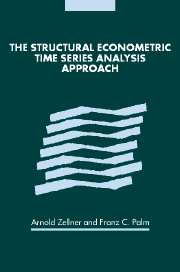Book contents
- Frontmatter
- Contents
- List of contributors
- Acknowledgments
- Introduction
- Part I The SEMTSA approach
- Part II Selected applications
- Part III Macroeconomic forecasting and modeling
- 13 Macroeconomic forecasting using pooled international data (1987)
- 14 Forecasting international growth rates using Bayesian shrinkage and other procedures (1989)
- 15 Turning points in economic time series, loss structures, and Bayesian forecasting (1990)
- 16 Forecasting turning points in international output growth rates using Bayesian exponentially weighted autoregression, time-varying parameter, and pooling techniques (1991)
- 17 Bayesian and non-Bayesian methods for combining models and forecasts with applications to forecasting international growth rates (1993)
- 18 Pooling in dynamic panel data models: an application to forecasting GDP growth rates (2000)
- 19 Forecasting turning points in countries' output growth rates: a response to Milton Friedman (1999)
- Part IV Disaggregation, forecasting, and modeling
- Subject index
- Author index
- References
14 - Forecasting international growth rates using Bayesian shrinkage and other procedures (1989)
Published online by Cambridge University Press: 24 October 2009
- Frontmatter
- Contents
- List of contributors
- Acknowledgments
- Introduction
- Part I The SEMTSA approach
- Part II Selected applications
- Part III Macroeconomic forecasting and modeling
- 13 Macroeconomic forecasting using pooled international data (1987)
- 14 Forecasting international growth rates using Bayesian shrinkage and other procedures (1989)
- 15 Turning points in economic time series, loss structures, and Bayesian forecasting (1990)
- 16 Forecasting turning points in international output growth rates using Bayesian exponentially weighted autoregression, time-varying parameter, and pooling techniques (1991)
- 17 Bayesian and non-Bayesian methods for combining models and forecasts with applications to forecasting international growth rates (1993)
- 18 Pooling in dynamic panel data models: an application to forecasting GDP growth rates (2000)
- 19 Forecasting turning points in countries' output growth rates: a response to Milton Friedman (1999)
- Part IV Disaggregation, forecasting, and modeling
- Subject index
- Author index
- References
Summary
Introduction
In our past work, Garcia-Ferrer et al. (1987), we employed several methods to forecast growth rates of real output (GNP or GDP) for eight European Economic Community (EEC) countries and the United States year by year for the period 1974–81. It was found that diffuse prior or least squares forecasts based on an autoregressive model of order 3 including leading indicator variables, denoted by AR(3)LI, were reasonably good in terms of forecast root mean-squared error (RMSE) relative to those of three naive models and of AR(3) models without leading indicator variables. Also, it was found that certain shrinkage forecasting techniques produced improved forecasting results for many countries and that our simple mechanical forecasts compared favorably with [Organization for Economic Cooperation and Development] (OECD) annual forecasts which were constructed using elaborate models and judgmental adjustments.
In the present chapter our main objectives are to extend our earlier work by (1) providing further analysis of shrinkage forecasting techniques, (2) providing forecasting results for an extended time period, 1974–84, for our past sample of nine countries, (3) applying our forecasting techniques to data relating to nine additional countries, and (4) reporting results of forecasting experiments using a simple modification of our AR(3)LI model.
The importance of checking the forecasting performance of our techniques using new data is reflected in objectives (2) and (3) above.
Information
- Type
- Chapter
- Information
- The Structural Econometric Time Series Analysis Approach , pp. 485 - 505Publisher: Cambridge University PressPrint publication year: 2004
References
Accessibility standard: Unknown
Why this information is here
This section outlines the accessibility features of this content - including support for screen readers, full keyboard navigation and high-contrast display options. This may not be relevant for you.Accessibility Information
- 1
- Cited by
